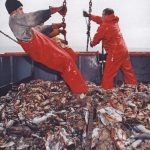Live fast and die young is a phrase commonly used by kids, those who never want to grow old.
It’s strange how their beliefs change when beyond the age of 30. Personally, I highly recommend staying alive for as long as possible!
But growing old among other species isn’t a choice, particularly with the higher end of the mollusc kingdom (cephalopods), where getting old is simply not possible. Squid, cuttlefish and many of the 250 or so species of octopus are lucky to see two years of life. Even the giant octopus can only stay around for a further 12 months.
However, one of the world’s most bizarre animals, the nautilus, stems back to when life began on Earth and may clock up as many as 20 years.
Main image: Cuttlefish, with a ‘shell’ developed internally as a buoyancy chamber, have control like that of a submarine – just far more refined. Many scientists say cephalopods such as cuttlefish are the weirdest creatures in the sea.

Jig-caught cephalopods can provide added data to the figures taken from those that are trawl-caught.
Of considerable economic importance to the UK, both squid and cuttlefish have a very short lifespan of just 18 months, so to reach maturity, the metabolism rate must rocket right from the first stage of life. The amount of food eaten must be enormous. However, UK scientists know very little of how much fish is eaten by cephalopods in British waters. Personally, I believe that the tonnage consumed is huge, and should be considered in the calculations of biomass and fish-stock recruitment.
Cuttlefish hold a high status in today’s overall catches at ports like Brixham and, were it not for the ‘black gold’ that such hauls of cuttlefish bring, then ports such as this would now be a fraction of their present selves. Without cuttlefish taking the place of dwindling sole quota, the bankruptcy of many vessel owners and merchants would be inevitable.
And on the life of squid and cuttlefish, let me share with you a recent BBC Radio Four programme In Our Time.
Introduced by broadcaster and writer Melvyn Bragg, a lengthy interview with leading scientists revealed that we are catching species (such as squid and cuttlefish) that in all likelihood are species with ‘considerable intelligence’.
“Intelligent, and yet so unlike other life forms on Earth, the cephalopods are part of the mollusc family and have characteristics in common with all other molluscs,” said Melvyn Bragg.
“What sets the cephalopods apart is the way in which members of that group can change colour, camouflage themselves, recognise people, solve problems, squirt ink, power themselves by jet propulsion, and may survive briefly on land, or be found in the deepest oceans. When considering evolution, cephalopods are, without doubt, the best adaptors and survivors in the animal kingdom.”
Rating cephalopods as some of the strangest of Earth’s creatures is a belief shared by Melvyn Bragg and his three guest scientists:
- Dr Louise Allcock, a lecturer in zoology at the National University of Ireland (in Galway)
- Paul Redhouse, honorary professor in the Department of Zoology at the University of Aberdeen, and marine living resources scientist for the British Antarctic Survey
- Jonathan Ablett from the Department of Life Sciences at the Natural History Museum, London, where research in the zoology of molluscs includes the adaptability of cephalopods.
Listeners heard how, among the cephalopods, the nautilus is one of the most bizarre animals. It has an outer shell, and the shape of the nautilus stretches back to the start of cephalopod evolution, yet members of that group still exist in the Indo-Pacific regions. And even stranger are squid-like species such as the vampiresquid, which will live at depths from 300ft (over 90m) to 3,000ft (900m).
There are cephalopods of one sort or another all around the world’s oceans, said Dr Louise Allcock, and summed it up by revealing: “Wherever you look in the oceans, you will probably find a cephalopod.”

The clump wire was too long, but after some calculations, and made 15ft shorter, it worked!
She explained how a lot of information on the distribution of cephalopods comes from fishery research scientists, yet further data obtained directly from the fishermen ‘is valued greatly’.
While that information allows scientists to discover habitats where a lot of cephalopods might be, Dr Allcock added, “If you trawl on the seabed you may catch octopuses or squids, but some can be found above the seabed too. Cephalopods live in lots of different habitats and behave in many different ways.”
Listeners heard that while some squid move to the ocean floor at night, when a bottom trawl will catch them, other species may not, and so data of their location would be unavailable. However, line-fishing with jigs provides data, as do catches from pelagic nets, but in the past few decades the development of technology has given scientists the use of remotely operated vehicles (ROVs) and hence, ‘plenty of ammunition’ is available to reveal more of the fascinating world of cephalopods.
“We can now deploy these (ROVs) to almost any depth, and we have seen parts of the oceans for the very first time, and we are finding cephalopods everywhere,” said Dr Allcock.
“There are not many organisms that can get everywhere, but one group of species that is unrivalled in where they live are cephalopods, probably because they are so flexible in their body shape and that their lifestyle is so vast. Cephalopods have diversified hugely into different forms, and have found unique ways of dealing with buoyancy. That has allowed them to exist both on the sea floor and literally anywhere in the water column. So cephalopods have been able to get into places that others haven’t.”
In terms of evolution, cephalopods stem back a long time, 600 million years, explained scientist Paul Redhouse. Evidence of cephalopods appears first in fossils, as a shell with chambers within it. These chambers could well have been gas-filled, and as they evolved, cephalopods developed a tube that connected the chambers, enabling them to pump water and/or gas in or out of the chambers to provide buoyancy control.
He explained that further evidence provided by fossils revealed that cephalopods ‘were there right at the outset of living creatures’ and thereafter from the Cambrian period, the evolution of cephalopods took place at a remarkably fast pace. Cephalopods began to diversify.
Paul Redhouse added, “At first, cephalopods mostly had external shells, but by the end of the Palaeozoic period (250 million years ago) forms were appearing where the shell was being developed inside the body (like the ‘bone’ of the cuttlefish and the stiffening-strip or ‘pen’ of the squid). However, around that time came the first of two near-extinctions, when around the world life forms were almost wiped out, yet cephalopods survived.
“It was a period when the planet Earth was in a more primitive state than it is now. A lot more volcanic activity was taking place, and it is thought that a period of extra volcanic activity occurred, which caused changes in the atmosphere and hence changes in the climate.
“It is hard to say, but there must have been massive changes in the environment. Species that had evolved to specialise in that environment would simply not have survived. Critically, many of the shelled cephalopods died out but a few made it through, and early forms of cephalopods that had evolved to lose the external shell, survived.”
When the age of the dinosaurs ended – about 65 million years ago – the second major event was equally tragic, and around 35% to 40% of all living creatures on Earth were wiped out. Whatever triggered those times of mass extinction is forever under debate, but whatever caused them, there were a few species of shelled cephalopods – and a few species of non-shelled cephalopods too – that made it through.

John ‘The Colonel’ Sanders said: “See Lockley, that’s how you do it. Don’t you dare put this in Fishing News!”
Scientists are still unsure of exactly what caused major change in the Earth’s environment, but many suggest either a meteorite colliding with the Earth, or huge volcanic activity were the best bets. And of the cephalopods that survived, fossil evidence shows that the nautilus types (cephalopods with external shells) were successful, and so were some species of non-shelled cephalopods, those resembling squids and/or cuttlefish.
“And from then on, evolution has led to the cephalopods we have today,” Paul Redhouse explained. (A considerable amount of fossil evidence of this is found in places like Lyme Regis in Dorset.)
Scientist Jonathan Ablett compared cephalopods against the wide range of molluscs that remain on Earth today, saying: “Molluscs are a very diverse group of animals. From slugs and snails right through to sea slugs, sea snails, squid, cuttlefish and octopus, there are features that link all species, for example, the nervous system. It does vary, but they all have a similar nerve pathway, and they all have a mantle, an area of tissue that surrounds the digestive and reproductive systems. In aquatic species, the mantle is often modified to provide breathing.
“All molluscs except bivalves (like oysters, cockles and scallops) have a ‘radula’ – a rasping tongue, which in snails grinds away at leaves – but in cephalopods the radula is helped by a beak system which rolls the tissue over and over, to be easily rasped away into more easily digested small particles.
“The shell also differs. With snails, it is an external shell, but for cephalopods (other than the nautilus) there are examples like cuttlefish where the shell has been modified to become a ‘bone’ of some sort. In squid, you have the internal ‘pen’ (gladius), and in octopus there are two main groups. One has completely lost its shell and the other group has a very small ‘vestigial shell’ – an organ that served a purpose in its distant ancestor but remains today with no true function.”
We must take a break here, but before we do, please share a wonderful memory of mine, of a trip I spent on the Brixham day-boat Ocean Spirit, just a few days after its launch.
This was owned by the ‘Colonel’ – skipper John Sanders (deceased 2009) – who had the Ocean Spirit built to make the most of twin-rigging for cuttlefish. He was one of a few who predicted the onset of what today is the lifeblood of Brixham’s fish landings. Over the past 12 months, ‘black gold’ has pushed the yearly grossing of such boats to heights that few would ever have imagined.
I can remember the Colonel very unhappy with the first haul and why the deck wasn’t blackened by cuttlefish ink!
But with his calculator, he found that the clump wire was 15ft or so too short. He corrected it, and the next haul was huge. Cuttlefish were everywhere, all over the deck and the crew were filling basket after basket. I will never forget the Colonel putting his hands on his hips, shouting: “See Lockley, that’s how you do it. Don’t you dare put this in Fishing News!”
I did!













